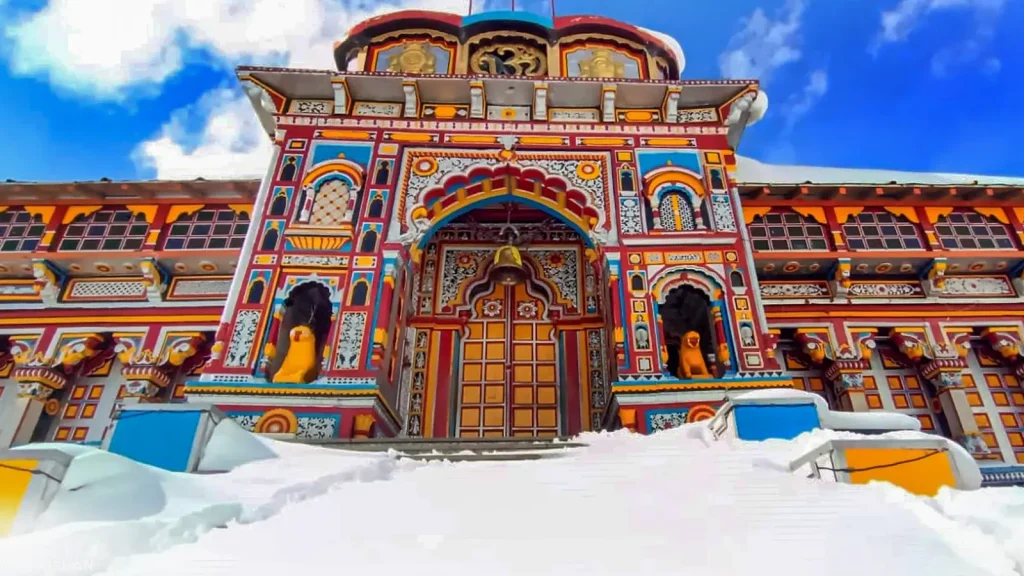
Want to see Badrinath under a soft white blanket, want simple steps to plan it, and want real stories that help you decide, read on and you’ll know when to go, what to pack, and how LIH Travel helps so your trip feels calm and safe. You can have a splendid journey to Badrinath with our Chardham Yatra by Helicopter tour!. Also check our Do Dham Yatra by Helicopter Tour, To visit Kedarnath ji and Badrinath ji in one day.
When does snowfall in Badrinath begin and what to expect
Badrinath sits high in the Himalayas and because it is high the snow comes early and stays late and light flurries often begin in late October while by December the whole valley turns thick with snow and the cold grows stronger between December and February and in some years the white patches stay even till March or April so it’s best to expect changing weather and pack warm clothes and always check updates before you leave
How snowfall in Badrinath changes the whole trip
Snow makes Badrinath look like a picture, the temple, the river and the prayer flags all look different, the air becomes very clear and the place grows very quiet, however snow also means roads can close, the temple can close for winter, and services like shops and buses may be limited, so you get the beauty but you also accept slower travel and more careful steps, LIH Travel plans both the magic and the safety so you can enjoy without surprise.
Best months to visit for snowfall in Badrinath
If you want to feel the first flakes, come in late October or early November, you may see soft snowfall and the roads and temple are usually still open, if you want deep snow and a true winter scene then December to February will give you that, however most hotels and the temple keep closed in heavy winter so you will need special plans, by March and April the snow melts and the pathways open again, so pick the time you like, and plan with LIH Travel if the weather looks tricky.
Simple packing list for snowfall in Badrinath
Pack smart, pack layers, bring things that keep you warm and dry and comfortable, here is a short list that works well:
- Thermal innerwear, warm fleece or wool sweaters, and a waterproof outer jacket
- Sturdy waterproof boots with good grip, extra warm socks, and a warm hat and gloves
- Sunglasses and sunscreen because the snow reflects light, medicines for cold and altitude if your doctor says so
- Small daypack for water, snacks, and a map or phone with offline directions
- Power bank for your phone, and a small torch in case power goes off
How to travel when there is snowfall in Badrinath
Travel slowly and plan for delays, always check the road status the day before you move, book a room in a place that knows how to handle snow, and choose drivers who have strong local experience, if the road closes or if weather becomes risky LIH Travel switches plans quickly and gives clear alternatives so you do not have to worry about staying stuck or unsafe.
What people say about seeing snowfall in Badrinath
Hearing real short stories helps you picture the trip, here are easy-to-understand notes from travelers:
- “We arrived and found a soft white path, we walked slowly and the view felt peaceful”
- “Our driver called ahead and the lodge kept our room warm, we left our shoes at the door and drank hot tea”
- “The temple looked tiny under the snow, the bells and chants sounded different and the quiet stayed with us for hours”
Safety tips for snowfall in Badrinath
Safety is simple when you follow a few rules, check forecasts and any avalanche warnings, if the road is closed do not try to push through, move slowly in snow and hold to railings, wear boots with grip, do not wander alone into unknown places, keep a phone charged and share your plan with someone, and always travel with a local guide or trusted agency like LIH Travel who gives updates and help when weather changes.
What to photograph during snowfall in Badrinath
Photos tell the memory, take pictures of the temple with snow on the roof, the river flowing beside white banks, prayer flags with a dusting of snow, footprints at dawn in fresh snow, and sunrise over the peaks, keep your camera dry, wipe the lens if snow melts on it, and pause to enjoy the view with your eyes before taking many photos.
How to keep your trip calm when weather changes
Plan for slow travel and carry patience, bring extra snacks and water, have warm layers handy in your daypack, book lodges that allow easy change of plans, learn a few local contacts for help, and trust a guide who knows the area well, LIH Travel gives all this support and helps you change the plan without panic so your trip stays peaceful.
Little things that make snow trips better
Small comforts help a lot, carry a warm water bottle, choose shoes that slip-resist on icy stairs, keep a small packet of dry socks and hand warmers, pack simple dry snacks like nuts and fruit, charge devices at night and keep a paper map in case signals drop, these small steps make a big difference when the weather plays tricks.
Why LIH Travel helps you enjoy snowfall in Badrinath
LIH Travel plans with care and local knowledge so you see the best without stress, we watch weather and road news, we book trusted drivers and lodges, we give a clear packing list and simple steps to follow, and if the road closes we give a plan B quickly so you can rest or change your route, this means your memory will be of quiet mornings and bright snow, not waiting in cold uncertainty.
Day ideas when snowfall in Badrinath surrounds you
Wake early and watch the sun hit the snow, walk slowly near the river and listen to water under the ice, visit the lower shrine if the main temple is closed, warm up with local tea and simple food, speak with lodge hosts about their winters and listen to their stories, take short walks only with a guide and stay hydrated, these small days turn into strong memories.
What to avoid during snowy days
Do not try to drive on closed roads, do not walk into unknown valleys alone, do not light open fires near dry prayer flags, avoid slick edges and thin ice on rivers, and do not leave warm clothing in a car where it can get damp, simple caution keeps your trip safe and smooth.
Final words about snowfall in Badrinath
Snowfall in Badrinath brings a quiet wonder as the whole place turns soft and still and you see fewer people and more open sky and you breathe the cold crisp air that makes you slow down naturally and with a bit of planning and a warm bag of clothes and a caring local team like LIH Travel you can truly meet the snow and return with a calm heart and a camera full of beautiful pictures and since the mountain weather changes fast it’s always wise to pack patience trust your guides and simply enjoy the long slow white days. You can have a splendid journey to Badrinath with our Chardham Yatra by Helicopter tour!. Also check our Do Dham Yatra by Helicopter Tour, To visit Kedarnath ji and Badrinath ji in one day.
Frequently Asked Questions about snowfall in Badrinath
- When does snowfall in Badrinath usually start ?
Often by late October and it grows heavier from December to February, some snow can stay into March or April. - Will the Badrinath temple be open during heavy snow ?
The temple often closes in heavy winter months, sometimes the idol is moved to a lower place so worship can continue. - Are roads to Badrinath safe in snow ?
Roads may be closed or slow when there is heavy snow, always check road status before you travel and travel with an experienced driver. - What is the best time to see snowfall in Badrinath and still visit easily ?
Late October to early November gives a good chance to see early snow while roads and services are more likely to be open.
Is it better to go with a local guide or alone ?
Going with a local guide or a trusted agency like LIH Travel is safer and easier, they know the road news and have local contacts to help if plans change.


